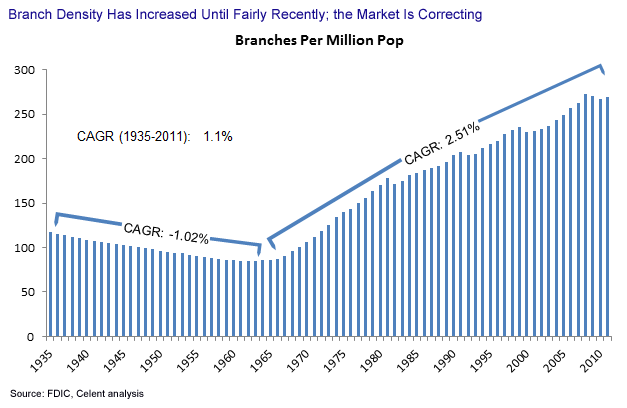Branch Boom Gone Bust: Predicting a Steep Decline in US Branch Density
Abstract
After 40 years of branch building, the US will witness a dramatic reduction in the number of operating branches.
In the report Branch Boom Gone Bust: Predicting a Steep Decline in US Branch Density, Celent argues that the US retail banking branch network has yet to respond to the obvious migration of customers to new digital alternatives.
Since 1970, the US has seen 281% growth in the number of FDIC-insured bank branches, with growth rates averaging 3% CAGR. Branch growth over the last 40 years has dramatically exceeded US population growth. In 1970, there were approximately 107 branches per million individuals. By 2011, that had grown to 270 branches per million.

“There is every reason to suggest branch densities would be substantially lower now than 30 years ago, but just the opposite has occurred. Given this trend, a slow, but inexorable reduction in US branch density seems unavoidable,” says Bob Meara, Senior Analyst with Celent’s Banking Group and coauthor of the report. “Beyond simply reducing the number of operating branches, what is needed is a fundamental redesign of retail operating models. Rather than resisting the trend, banks should welcome it and reinvest the savings.”
“If banks don’t align their multichannel strategies with this seismic shift in consumer preference, they’ll be at a significant competitive disadvantage,” adds Stephen Greer, Analyst with Celent’s Banking Group and coauthor of the report. “Financial institutions have their work cut out for them because transforming the branch network is neither cheap nor easy.”
This report examines the US branch boom phenomenon, showing how the big banks own the historic overinvestment. The report then examines multiple US retail market segments and developed market retail banking demographics to show that the US branch boom is an anomaly. The report makes multiple arguments for the inevitability of US branch channel right-sizing based on global changes in consumer preference. Finally, Celent provides a look forward, examining how financial institutions are acting, given the decline in branch traffic.
This 32-page report contains 28 figures and three tables.

